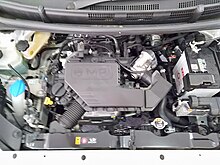Hyundai Epsilon engine
| ε-engine | |
|---|---|
 Hyundai Epsilon 999cc L4 engine (G4HC) | |
| Overview | |
| Manufacturer | Hyundai Motor Company |
| Layout | |
| Configuration | Straight-3 Straight-4 |
| Displacement |
|
| Cylinder bore |
|
| Piston stroke |
|
| Valvetrain | SOHC 2 or 3 valves x cyl. |
| Combustion | |
| Turbocharger | Yes (0.8L TCI) |
| Fuel system | Fuel injection |
| Fuel type | Gasoline LPG |
| Cooling system | Water-cooled |
| Output | |
| Power output | 48–70 PS (35–51 kW; 47–69 hp) |
| Torque output | 6.6–10.5 kg⋅m (65–103 N⋅m; 48–76 lbf⋅ft) |
| Chronology | |
| Successor | Kappa |
Hyundai's Epsilon engine is a category of small inline gasoline automobile engines.
0.8 L (G3HA/G3HG)
The G3HA and G3HG engines are a 3-cylinder, 9 valves, SOHC, 0.8 L (814 cc) version with a 67 mm × 77 mm (2.64 in × 3.03 in) bore and stroke. Output is 56 PS (41 kW; 55 hp) at 5,500 rpm and 7.6 kg⋅m (75 N⋅m; 55 lbf⋅ft) at 4,000 rpm.[1] This engine has been used in Hyundai's small hatchback Hyundai Eon. As the name suggests, this engine is a G4HG engine with one fewer cylinders mainly designed for high fuel efficiency.
0.8 L (G4HA)
The G4HA is a 4-cylinder, 0.8 L (798 cc) version with a 63 mm × 64 mm (2.48 in × 2.52 in) bore and stroke. Output is 54 PS (40 kW; 53 hp) at 6,000 rpm and 7.4 kg⋅m (73 N⋅m; 54 lbf⋅ft) at 4,000 rpm.
0.8 L LPG (L4HA)
The L4HA is a 4-cylinder, 0.8 L (798 cc) LPG version with a 63 mm × 64 mm (2.48 in × 2.52 in) bore and stroke. Output is 48 PS (35 kW; 47 hp) at 6,000 rpm and 6.6 kg⋅m (65 N⋅m; 48 lbf⋅ft) at 4,000 rpm.
0.8 L TCI (G4HA)
The G4HA is a turbocharged 4-cylinder, 0.8 L (798 cc) version with a 63 mm × 64 mm (2.48 in × 2.52 in) bore and stroke. Output is 70 PS (51 kW; 69 hp) at 6,000 rpm and 10.5 kg⋅m (103 N⋅m; 76 lbf⋅ft) at 4,000 rpm.
1.0 L (G4HC/G4HE)
The G4HC/G4HE is a 4-cylinder 3 valves per cylinder engine that displaces 1.0 L (999 cc) with a larger 66 mm × 73 mm (2.60 in × 2.87 in) bore and stroke.
The G4HC power is 54–58 PS (40–43 kW; 53–57 hp) at 5,700 rpm and 7.4–8.6 kg⋅m (73–84 N⋅m; 54–62 lbf⋅ft) at 3,000 rpm. This engine has been used in Hyundai's Hatchback Atos/Santro.
The G4HE power is 61–72 PS (45–53 kW; 60–71 hp) at 5,600–6,000 rpm and 8.8–9.2 kg⋅m (86–90 N⋅m; 64–67 lbf⋅ft) at 4,500 rpm. This engine has been used in the Kia Picanto.
1.0 L LPG (L4HE)
The L4HE is a 4-cylinder, 1.0 L (999 cc) LPG version with a 66 mm × 73 mm (2.60 in × 2.87 in) bore and stroke. Output is 67–72 PS (49–53 kW; 66–71 hp) at 5,600–6,000 rpm and 9–9.2 kg⋅m (88–90 N⋅m; 65–67 lbf⋅ft) at 3,000–4,500 rpm.
1.1 L (G4HD/G4HG)

The G4HD/G4HG is a 4-cylinder 3 valves per cylinder engine that displaces 1.1 L (1,086 cc) with a larger 67 mm × 77 mm (2.64 in × 3.03 in) bore and stroke. This engine has been used in Hyundai's i10 (PA), Atos, Santro Xing cars and Kia Picanto. Firing Order of this engine is 1-3-4-2 and idle RPMs are 750± 100.
The G4HD power is 60–64 PS (44–47 kW; 59–63 hp) at 5,500 rpm and 8.9–9.6 kg⋅m (87–94 N⋅m; 64–69 lbf⋅ft) at 2,800 rpm.
The G4HG power is 64–70 PS (47–51 kW; 63–69 hp) at 5,500 rpm and 9.9–10.1 kg⋅m (97–99 N⋅m; 72–73 lbf⋅ft) at 2,800–4,500 rpm.[2]
The CNG version of the engine is rated 60 PS (44 kW; 59 hp) at 5,500 rpm and 8.7 kg⋅m (85 N⋅m; 63 lbf⋅ft) at 4,500 rpm.
See also
References
- ^ "Archived copy" (PDF). Archived from the original (PDF) on 2012-08-12. Retrieved 2012-09-28.
{{cite web}}: CS1 maint: archived copy as title (link) - ^ "KIA : United Arab Emirates". Archived from the original on 2012-04-26. Retrieved 2011-12-27.
